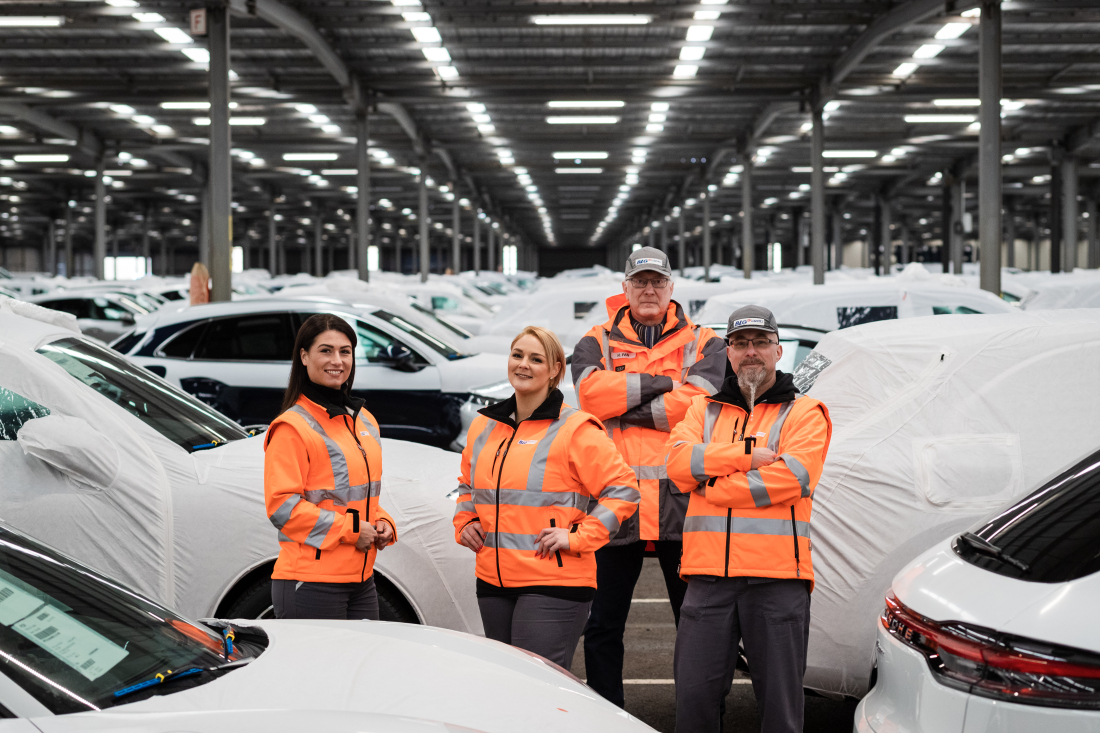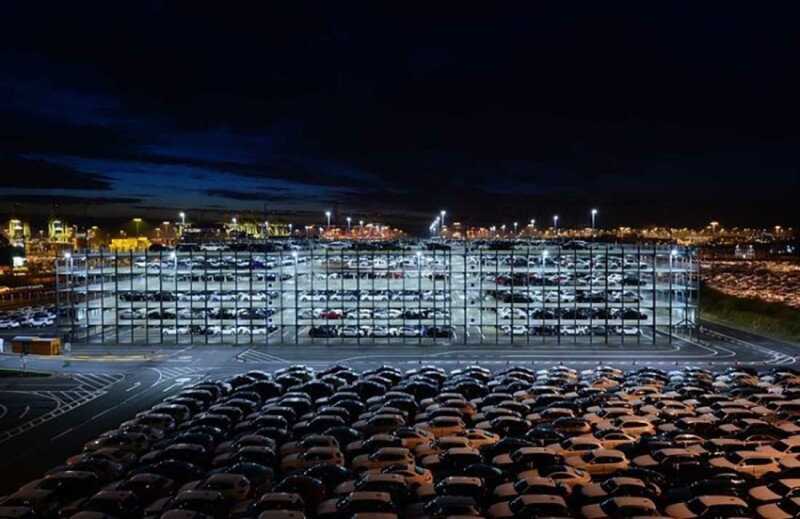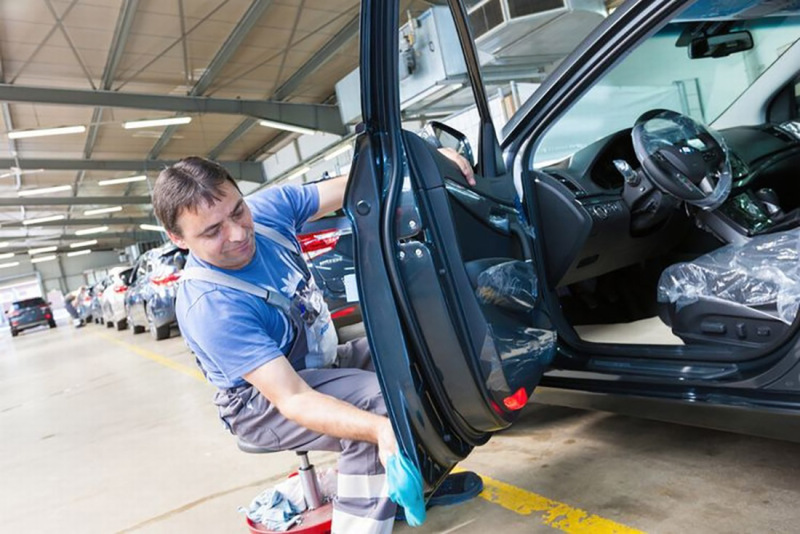The biggest car park in Europe
Automotive IndustriesBLG LOGISTICS GROUP AG & Co. KG’s AutoTerminal in Bremerhaven is a record-breaking automotive hub

With over 1.7 million vehicles handled per year, the AutoTerminal Bremerhaven is one of the largest car ports in the world. All the well-known car shipping companies serve Bremerhaven regularly and more than 1,000 car carriers call at the terminal every year. The AutoTerminal has open and covered storage facilities.
9 ship berths for car carriers, 16 rail ramps and four truck entrance gates bear witness to the continuous flow of vehicles to be handled at Bremerhaven's riverside quay, the „Stromkaje“.
Bremerhaven: one of the largest car ports in the world
The giant container ships heading for the quays at Bremerhaven hold more than 8,000 cars. BLG’s AutoTerminal is particularly striking when seen from the air: row upon endless row of (mostly) brand new cars, partially covered with white, protective film during transportation, give the effect of a huge patchwork carpet – mainly ‘woven’ out of steel and aluminium.
Vehicles are not only loaded and unloaded, but are also processed, repaired, converted, fitted out with extra features, and finished off at BLG’s Bremerhaven AutoTerminal.
With more than 2,000 employees, Bremerhaven is the largest facility in BLG’s AUTOMOBILE division
The company’s network of terminals covers 15 locations in Germany, Poland, Slovenia and Ukraine. The seaport terminals on the coast in particular serve as hubs, and are export gateways for European vehicle manufacturers shipping their products overseas to markets including China, Japan, Korea, the US, Australia, South Africa and Scandinavia. Bremerhaven is a regular port of call for shipping companies such as Eukor, Wallenius Wilhemsen, Höegh, Hyundai Glovis, MOL, K-Line and NYK with their box-shaped roll-on/roll-off (ro-ro) ships.
"All terminals are linked to each other and have intermodal transport connections by truck, rail or inland waterway vessel. This ensures continuous logistics chains to the customers," says Axel Bantel, Managing Director of BLG AUTOMOBILE LOGISTICS.
The Bremerhaven car hub is also driving employment. It features Europe’s largest automotive workshop, which alone employs 400 people.

70,000 parking spaces, more than half of which are covered
Sometimes, vehicles spend only one day in the terminal before being shipped out or transported onwards (export) and stays of more than two months are unusual (import). Covering some 295 hectares, BLG’s site has space to park approximately 70,000 cars. "As a seaport, we have proven our reliability even in times of multi-crises," explains Jan Rosenkranz, Managing Director of BLG AutoTerminal Bremerhaven.
The added value of imported vehicles is highest due to the sometimes extensive technical processing. Due to the relocation of production by German manufacturers abroad, "German" vehicles are also imported, for example BMW and Mercedes from US production.
BLG not only organises the transshipment. With 1,500 of its own rail wagons specially designed for car transport and its own fleet of trucks, it ensures that the vehicles reach their destination.
‘Wash, lay and blow-dry’ in Europe’s largest automotive workshop
BLG also operates a number of technology centres in Bremerhaven, which are together described as the ‘biggest automotive workshop in Europe’. Some 300,000 vehicles are washed and checked every year.
Other services include the installation of special equipment and accessories (e.g. leather upholstery, air conditioning, navigation systems). In addition, PDI (Pre Delivery Inspection), special paintwork and conversions (e.g. to LPG) to suit the country of destination are part of the daily business.

What started off 50 years ago as a simple vehicle transshipment service has since evolved into a comprehensive and increasingly differentiated portfolio of services for manufacturers. BLG LOGISTICS also offers vehicle valuation, for example, as well as fleet and rental preparation, and marketing preparation for vehicles (e.g. photo shoots and vehicle auctions).
BLG AutoTec mainly processes imported vehicles made by 18 different manufacturers. Mercedes-Benz, BMW, Genesis, Great Wall, Hyundai, Kia, Mitsubishi, Stellantis, Suzuki and Isuzu are among the main customers. Some vehicles for export also pass through the BLG technical centre and receive underbody protection, for example.

Expansion of the High & Heavy division
From July 1st, 2023, BLG LOGISTICS will lease an attractive area in the immediate vicinity of the AutoTerminal. The so-called MWB area at Barkhausenstraße 60 comprises 60,000m² of open and hall space as well as two ship berths with a 600-metre quay.
"With this investment, we are responding to the increased demand in the handling of self-propelled units, breakbulk cargo as well as project cargo and strengthening our High & Heavy segment in the AUTOMOBILE division," explains Matthias Magnor, Member of the Board of Management and Chief Operating Officer (COO) of the BLG Group.
Success Stories
Bremen’s Economy in Figures: Statistics 2025
The State of Bremen is a strong economic hub. A look at the latest statistics highlights its economic strength — summarising key data such as cargo volumes, export performance, industry turnover, and more.
Learn moreMedium-Sized Companies in Bremen Showcasing the Full Range of the Local Economy
Medium-sized companies form the backbone of Bremen’s economy. They create jobs and produce goods that are in demand worldwide. Here is a selection of ten businesses that illustrate the diversity of Bremen’s economic landscape.
Learn moreTwelve international food and beverage companies in Bremen
Becks and Melitta may be high-profile brands, but international food and beverage companies also manufacture lots of other products in Bremen and Bremerhaven. Here are twelve examples.
Learn more
